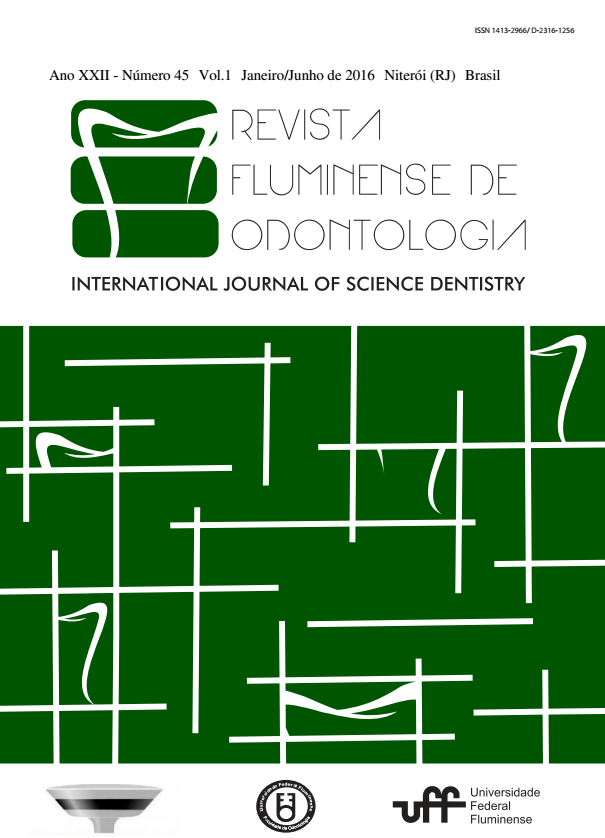EFEITO DO DESAFIO EROSIVO IN VITRO NA MASSA E RUGOSIDADE SUPERFICIAL DE DIFERENTES MATERIAIS RESTAURADORES
DOI:
https://doi.org/10.22409/ijosd.v1i45.325Resumo
RESUMO
O objetivo deste estudo in vitro foi avaliar alteração de massa e de rugosidade superficial utilizando balança eletrônica e rugosímetro respectivamente, de quatro materiais odontológicos: resina composta (RC), selante resinoso (SR), cimento de ionômero de vidro resinoso (CIVR) e cimento de ionômero de vidro (CIV) convencional após serem submetidos à desafio erosivo (DE). Foram confeccionados 24 corpos de prova de cada material sendo divididos em 3 grupos (N=8): GI – bebida carbonatada a base de cola (Coca cola®; pH 2.6); GII – suco de laranja a base de soja (Ades®; pH 4.4); e GIII – saliva artificial (SA) (pH 7; controle). DE foi realizado através de imersão nas respectivas soluções (20mL/amostra) durante 3x/5min/dia por cinco dias. As amostras foram armazenadas em SA entre os DE e pernoite. Os dados foram analisados estatisticamente no software SPSS v.20 através dos testes ANOVA, post-hoc de Tukey, Kruskal-Wallis e Student-Newman Keuls com nível de significância de p<0,05. Observou-se que, todos os materiais apresentaram alteração de massa, sendo que RC e SR apresentaram aumento, porém significante (p<0,01) apenas para SR; já CIVR e CIV tiveram perda significativa (p<0,01). Em relação à rugosidade, todas as soluções promoveram alteração, porém não significativa (p>0,05). Houve aumento da rugosidade da RC no suco de laranja e do SR, no refrigerante e SA. O CIV apresentou aumento da rugosidade no refrigerante e o CIVR, redução em todas as soluções. Concluiu-se que, as soluções testadas promoveram redução de massa e o refrigerante aumento de rugosidade apenas para os materiais ionoméricos, principalmente, o convencional.
Palavras-chave: Resina composta, Cimento de ionômero de vidro, Selante de sulcos e fissuras, Erosão
ABSTRACT
The aim of this in vitro study was to evaluate mass change and surface roughness using analytical scale and profilometer respectively, of four dental materials: composite resin (CR), resin sealant (RS), resin-modified glass-ionomer cement (RMGIC) and glass-ionomer cement (GIC) for restoration after being submitted to erosive challenge (EC). Twenty-four samples of each material were prepared and divided into 3 groups (n=8): GI- cola soft drink (Coca-Cola®; pH 2.6); GII – soya orange juice (Ades®; pH 4.4); and GIII - artificial saliva (AS) (pH 7; control). EC was conducted by immersion in the respective solutions (20ml/sample) for 3x/5min/day during five days. Samples were stored in AS between EC and overnight. Data were statistically analyzed using SPSS v.20 software through ANOVA, Tukey’s post-hoc, Kruskal-Wallis and Student-Newman- Keuls with significance level of p<0.05. It was observed that all materials had mass change, and CR and SR showed an increase, being significant (p<0.01) only for SR; whereas RMGIC and GIC had significant loss (p<0.01). Regarding the surface roughness, all solutions promoted changes, but not significant (p>0.05). There was an increase in roughness of CR in orange juice and SR in soft drink and AS. GIC showed increased roughness in soft drink and RMGIC, reduction in all solutions. It was concluded that, the tested solutions promoted mass reduction and the soft drink increased roughness only for the ionomeric materials, mainly, the self-cured.
Keywords: Composite resin, Glass-ionomer cement, Pit and fissure sealant, Erosion


